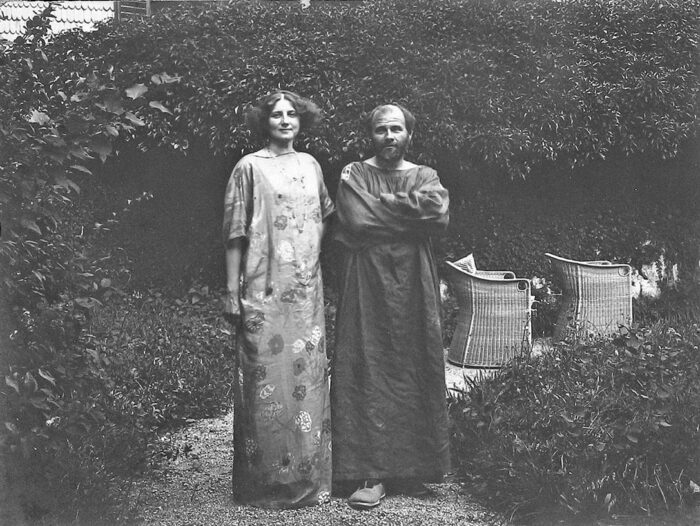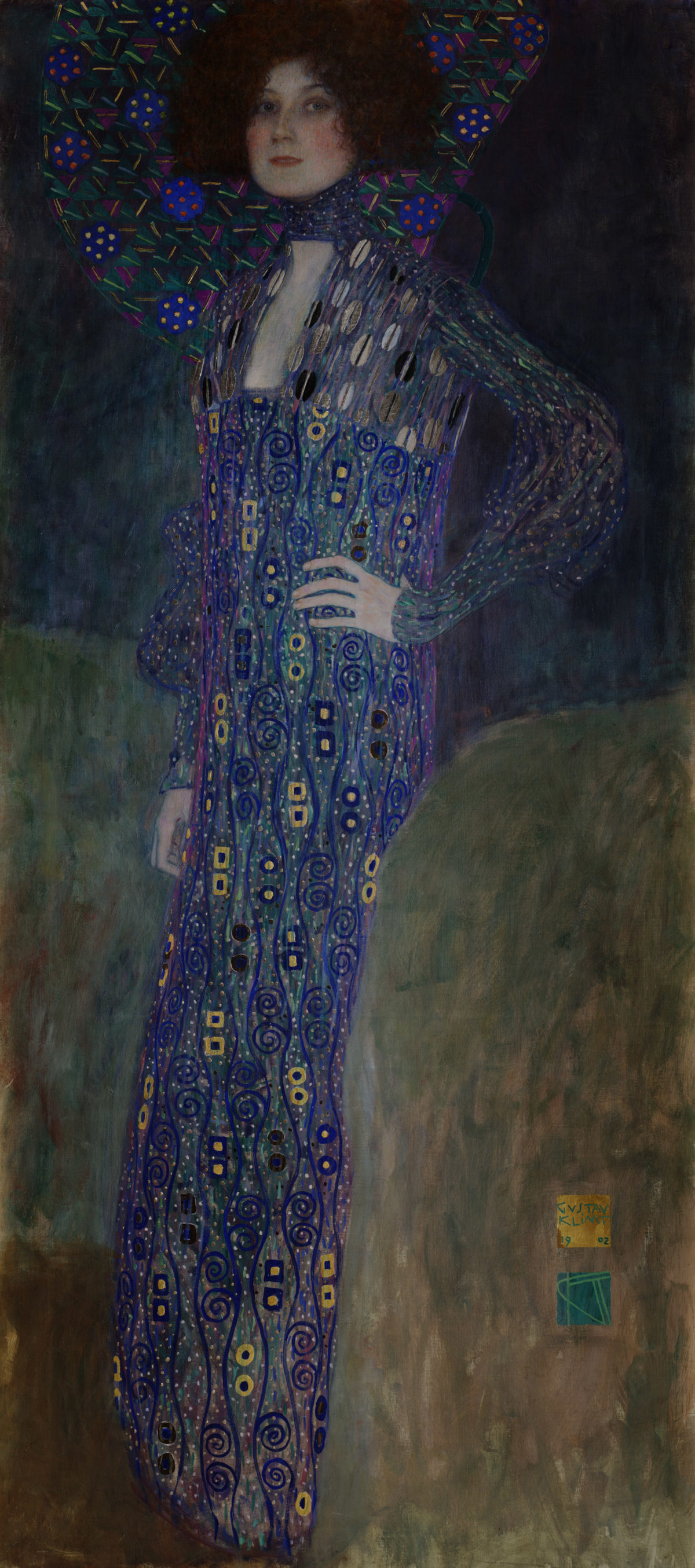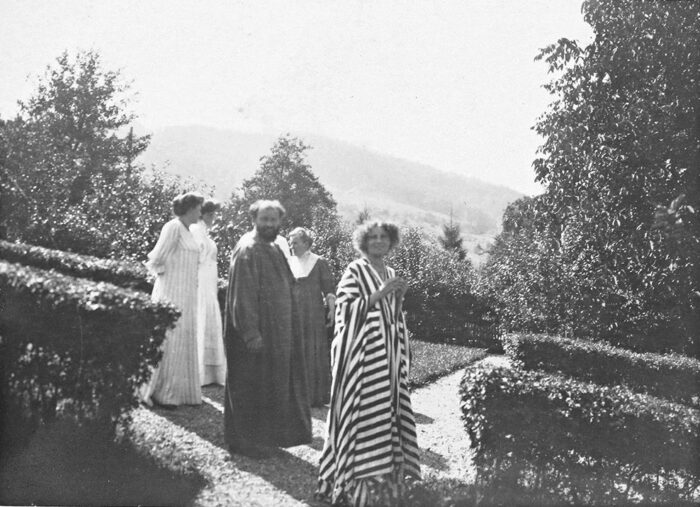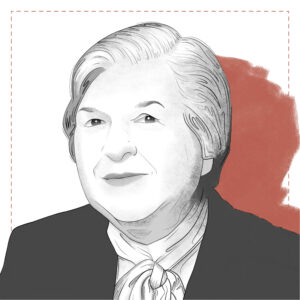Emilie Flöge | Profiles in Sewing History
This business-savvy designer defied society’s norms and aimed to free women from restrictive clothing
Meet Emilie Flöge. In the second installment of our Profiles in Sewing History series, Threads features this revolutionary woman who never made it into the spotlight. A couturier, she possessed a strong business sense and a desire to free women from restrictive clothing so they could make a difference in society. Nevertheless, she is rarely known for her design ability and is often referred to simply as painter Gustav Klimt’s muse.
Emilie Flöge’s family and childhood
Emilie was born on August 30, 1874 in Vienna, Austria. She was the youngest of four children. Her siblings were Pauline, Helene, and Hermann. Emilie had a typical middle-class upbringing but became close with the Klimt family when her sister, Helene, married Gustav Klimt’s brother, Ernst, in 1891. Unfortunately, Ernst died 15 months later at age 28. Helene was pregnant at the time, and Gustav stepped in to assist the Flöge family. He ended up spending a many hours at the Flöge house and became particularly close with Emilie, who was 12 years younger.

Gustav was already a prolific artist and decided to use Emilie as a model for one of his paintings. The two inspired each other throughout their careers and had a strong affection for one another. In fact, one of Gustav’s most famous paintings (shown below) was of Emilie at 28 years old in one of her signature dress designs. While some assume Emilie and Gustav were romantically involved, many scholars believe they maintained a platonic relationship.

A humble beginning
Emilie began her career as a seamstress and started working at her eldest sister’s dressmaking school in 1895. Four years later, Emilie and Pauline entered a dressmaking competition and won. From then on, sewing and design took center stage in their lives. By 1904, their sister Helene even took an interest and started working with Pauline and Emilie. The trio opened a boutique, aptly named Schwestern Flöge (meaning Flöge Sisters). The business was on a main shopping street in Vienna, known as Mariahilfer Strasse, and featured haute couture fashions ranging from dresses and jackets to evening gowns and suits. It was rare for three unmarried women in their 30s to own a business over 100 years ago, but this is just the beginning of what set Schwestern Flöge apart.

Creating the business
As the main shop owner, Emilie sought to push the envelope with her designs and her business strategy. In terms of design, she was passionate about freeing women from the constricting bustles, corsets, and crinolines that were in style. Her design views aligned with those of the Rational Dress Society movement, which aimed to dress women in a way that allowed them to breathe freely and move more easily in their clothes. In addition to being a health concern, restrictive clothing was thought to hold women back from being physically and socially active in society. As a result, Emilie’s signature designs featured loose-fitting, empire-waist garments with wide sleeves and intricately detailed panels. This style of dress was revolutionary at the time, but is still seen in fashion today. Since not everyone was ready to adopt this new style of dress, Schwestern Flöge sold mainstream garments as well. This helped ensure the store turned a profit.
Emilie was a forward-thinking businesswoman. She didn’t rely solely on her designs to draw customers into the store. She wanted clients to feel as though they were having a grand shopping experience. For this reason, she decorated her salon with beautiful artworks that were just for show. The furniture on display was also unique and welcoming and reflected the modern Viennese art movement of the time.
Clearly, Emilie was doing something right because the store became a great success. At its peak, the Schwestern Flöge workshop was rumored to have had two large cutting tables and nearly 80 dressmakers. It also helped that Emilie was a close friend of Gustav Klimt. He introduced many of his upper-class clients to her store, which brought in a lot of business.

The fall of Schwestern Flöge
While Schwestern Flöge thrived for 34 years, the Nazi invasion in 1938 caused much of the store’s clientele to flee. The shop was forced to close. Emilie continued to work from her home, but the business was never the same.
In fact, toward the end of World War II, Emilie’s house caught fire and destroyed many of her designs and several of Gustav’s works that were in her possession. Emilie died on May 26, 1952.
A feminist legacy

Although the sisters’ business came to an end, there is a lot to learn from Emilie’s story. This early feminist lived a free, independent life and dressed the way she wanted to dress. Even at a time when women had little autonomy, Emilie strayed from society’s norms and made her own decisions. She followed her dreams, trusted her instincts, and maintained a hands-on approach to her business. In addition to running the store operations, Emilie helped make the product by draping her own designs. As a result, her store was truly a success. It was considered a leading fashion destination for Viennese society and beyond. More than 100 years later, Emilie’s design influence remains part of stylish fashion.
For more information about Emilie Flöge and Gustav Klimit, visit the Klimt Foundation online and on Facebook.
What part of Emilie’s story do you find most inspiring? Please share your thoughts in the comments below.
Illustration: Steven Fleck.
Click here for the first installment of Profiles in Sewing History, a Threads series about the lesser known individuals who made a difference in the world of fashion and sewing.
Sources
Darcella, Aria, and Benjamin Galopin. “CR Muse: Emilie Flöge and the Art of Fashion,” August 28, 2018, https://www.crfashionbook.com/culture/a22835087/emilie-floge-art-fashion-cr-muse/.
“Emilie Louise Floge (1874-1952).” Mahler Foundation. Accessed October 11, 2020, https://mahlerfoundation.org/mahler/personen-2/floge-emilie-louise-1874-1952.
Fischer, Wolfgang Georg. Klimt and Emilie: a Painter and His Muse. Woodstock, NY: The Overlook Press, 1992.
Furman, Anna. “Before Coco Chanel There Was Emilie Flöge: A Designer the Fashion Industry Forgot.” Harper’s Bazaar, September 19, 2017, https://www.harpersbazaar.com/culture/art-books-music/a12241915/klimt-muse-emilie-floge-forgotten-fashion-designer/.
Grytsan, Sofi. “Gustav Klimt and Emilie Flöge: Who got inspired by whom.” L’Officiel, March 14, 2019, https://www.lofficiel.at/en/art%20&%20culture/gustav-klimt-and-emilie-floge-who-got-inspired-by-whom.
National Gallery of Victoria Vienna Art and Design. “Fashion: Emilie Flöge.” Accessed October 11, 2020, https://www.ngv.vic.gov.au/vienna/fashion/emilie-floge.html.
Portrait of Emilie Floge, 1902 by Gustav Klimt. Accessed October 11, 2020, https://www.gustav-klimt.com/Portrait-of-Emilie-Floge.jsp.




































A fascinating mini-biography. I admire Klimt's work and it is wonderful to find a fashion connection through his muse. Emilie Floge is inspiring in that she followed her instincts and developed her personal skill into a profession.